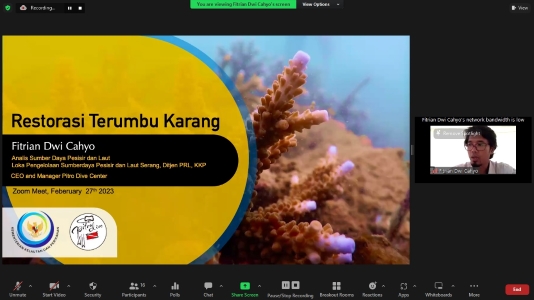Department of Marine Science and Technology (ITK) IPB University Shares Coral Reef Restoration Knowledge with LPSPL Serang

The Department of Marine Science and Technology (ITK) IPB University never stops voicing the importance of protecting marine ecosystems through the School of Coral Reef Restoration (Scores) Season 2. Themed 'Coral Reef Restoration', at this chance, Scores present guest speaker, Fitrian Dwi Cahyo, from the Resource Management Workshop Coastal and Sea (LPSPL) Serang.
Dr Beginer Subhan, Secretary of the ITK Department IPB University in his remarks said, "We know that the Serang LPSPL program is very much related to restoration activities and involves the community. I hope that the experience shared by LPSPL Serang through these Scores can give information about coral restoration in Indonesia because we realize that not all restoration activities are in the journal and not everyone writes them down.”
In his presentation, Fitrian Dwi Cahyo said that the sea is often associated with coral reefs. It is because coral reefs are rich in benefits for nature and humans. Coral reefs have 'use' and 'non-use' benefits.
"But behind the various benefits that we can get, coral reefs have a big risk of extinction threats, both by nature and humans," he said.
He explained Hard Coral Conservation status has been regulated in Government Regulation (PP) No. 7 of 1999. Meanwhile, internationally it is protected by Appendix II of The Convention on International Trade in Endangered Species of Wild Fauna and Flora (CITES). This means said Fitrian, coral reefs can be traded under certain conditions. At the same time, the category is regulated in the International Union of Conservation of Nature (IUCN).
“Why can coral reefs be traded internationally even though they are fully protected? So, of course, there are several requirements, one of them is the coral reefs that can be used must be F2 coral or cultivated coral reefs, "explained Fitrian.
He explained that cultivated coral reefs were made using various methods such as the iron rack method, cast concrete bars, cast concrete pots, and the stepping method. This is followed by routine monitoring by measuring and recording coral height, number of dead seedlings, associated biota, shelf conditions, height gain, mortality, and survival rate.
From an economic perspective, Fitrian continued, coral reefs have functions and benefits. But on the other hand, it is also necessary to limit exploitation activities with regulations so that the balance of the ecosystem is maintained. For example by limiting fishing results and the existence of conservation zones, limiting coastal activities so that the function of coral reefs as coastal protectors is maintained, imposing restrictions on tourism activities such as diving, and limiting export quotas of ornamental corals for aquascapes.
"In other words, there is a lot of potential that must be supported by the development of various adequate facilities and infrastructure, for example, snorkeling and diving tours, integration of conservation area tourism, and other ecotourism developments that can be developed through local government policies in the fields of maritime affairs, fisheries, tourism, and the economy creative," said Fitrian Dwi Cahyo as a closing statement. (DHAA/ARS/Rz) (IAAS/HAP)


